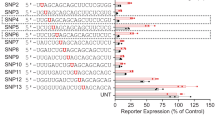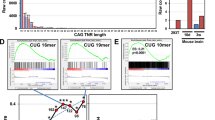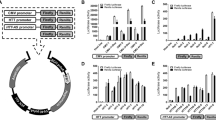Abstract
Expanded trinucleotide repeats1 cause many neurological diseases. These include Machado-Joseph disease (MJD)2 and Huntington's disease (HD)3, which are caused by expanded CAG repeats within an allele of the ataxin-3 (ATXN3) and huntingtin (HTT) genes, respectively. Silencing expression of these genes is a promising therapeutic strategy, but indiscriminate inhibition of both the mutant and wild-type alleles may lead to toxicity, and allele-specific approaches have required polymorphisms that differ among individuals. We report that peptide nucleic acid and locked nucleic acid antisense oligomers that target CAG repeats can preferentially inhibit mutant ataxin-3 and HTT protein expression in cultured cells. Duplex RNAs were less selective than single-stranded oligomers. The activity of the peptide nucleic acids does not involve inhibition of transcription, and differences in mRNA secondary structure or the number of oligomer binding sites may be important. Antisense oligomers that discriminate between wild-type and mutant genes on the basis of repeat length may offer new options for developing treatments for MJD, HD and related hereditary diseases.
This is a preview of subscription content, access via your institution
Access options
Subscribe to this journal
Receive 12 print issues and online access
$209.00 per year
only $17.42 per issue
Buy this article
- Purchase on Springer Link
- Instant access to full article PDF
Prices may be subject to local taxes which are calculated during checkout




Similar content being viewed by others
References
Orr, H.T. & Zoghbi, H.Y. Trinucleotide repeat disorders. Annu. Rev. Neurosci. 30, 575–621 (2007).
Paulson, H.L. Dominantly inherited ataxias: Lessons learned from Machado-Joseph disease/spinocerbeller ataxia type 3. Semin. Neurol. 27, 133–142 (2007).
Walker, F.O. Huntington's disease. Lancet 369, 218–228 (2007).
Gusella, J.F. & MacDonald, M.E. Huntington's disease: seeing the pathogenic process through a genetic lens. Trends Biochem. Sci. 31, 533–540 (2006).
Kremer, B. et al. A worldwide study of the Huntington's disease mutation: The sensitivity and specificity of measuring CAG repeats. N. Engl. J. Med. 330, 1401–1406 (1994).
Boado, R.J., Kazantsev, A., Apostol, B.L., Thompson, L.M. & Pardridge, W.M. Antisense-mediated down-regulation of the mutant human huntingtin gene. J. Pharmacol. Exp. Ther. 295, 239–243 (2000).
Harper, S.Q. et al. RNA interference improves motor and neuropathological abnormalities in a Huntington's disease mouse model. Proc. Natl. Acad. Sci. USA 102, 5820–5825 (2005).
Denovan-Wright, E.M. & Davidson, B.L. RNAi: a potential therapy for the dominantly inherited nucleotide repeat diseases. Gene Ther. 13, 525–531 (2006).
Wang, Y.-L. et al. Clinico-pathological rescue of a model mouse of Huntington's disease by siRNA. Neurosci. Res. 53, 241–249 (2005).
DiFiglia, M. et al. Therapeutic silencing of mutant huntingtin with siRNA attenuates striatal and cortical neuropathology and behavioral deficits. Proc. Natl. Acad. Sci. USA 104, 17204–17209 (2007).
Miller, V.M. et al. Allele-specific silencing of dominant disease genes. Proc. Natl. Acad. Sci. USA 100, 7195–7200 (2003).
Schwarz, D.S. et al. Designing siRNA that distinguish between genes that differ by a single nucleotide. PLoS Genet. 2, e140 (2006).
Rodriguez-Lebron, E. & Paulson, H.L. Allele-specific RNA interference for neurological disease. Gene Ther. 13, 576–581 (2006).
van Bilsen, P.H.J. et al. Identification and allele-specific silencing of the mutant huntingtin allele in Huntington's disease patient-derived fibroblasts. Hum. Gene Ther. 19, 710–718 (2008).
Alves, S. et al. Allele-specific RNA silencing of mutant ataxin-3 mediates neuroprotection in a rat model of Machado-Joseph disease. PLoS One 3, e3341 (2008).
Zhang, Y., Engelman, J. & Friedlander, R.M.J. Allele-specific silencing of mutant Huntington's disease gene. J. Neurochem. 108, 82–90 (2009).
De Souza, E.B., Cload, S.T., Pendergrast, P.S. & Sah, D.W. Novel therapeutic modalities to address nondrugable protein interaction targets. Neuropsychopharmacology 34, 142–158 (2009).
Nasir, J. et al. Targeted disruption of the Huntington's disease gene results in embryonic lethality and behavioral and morphological changes in heterozygotes. Cell 81, 811–823 (1995).
White, J.K. et al. Huntingtin is required for neurogenesis and is not impaired by the Huntington's disease CAG expansion. Nat. Genet. 17, 404–410 (1997).
Sobczak, K., de Mezer, M., Michlewski, G., Krol, J. & Krzyzosiak, W.J. RNA structure of trinucleotide repeats associated with human neurological diseases. Nucleic Acids Res. 31, 5469–5482 (2003).
Marin, V.L. & Armitage, B.A. RNA guanine quadruplex invasion by complementary and homologous PNA probes. J. Am. Chem. Soc. 127, 8032–8033 (2005).
Hu, J. & Corey, D.R. Inhibiting gene expression with peptide nucleic acid (PNA)-peptide conjugates that target chromosomal DNA. Biochemistry 46, 7581–7589 (2007).
Slow, E.J. et al. Selective striatal neuronal loss in a YAC128 mouse model for Huntington disease. Hum. Mol. Genet. 12, 1555–1567 (2003).
Tang, T.-S. Disturbed Ca2+ signaling and apoptosis of medium spiny neurons in Huntington's disease. Proc. Natl. Acad. Sci. USA 102, 2602–2607 (2005).
Knudsen, H. & Nielsen, P.E. Antisense properties of duplex- and triplex-forming PNAs. Nucleic Acids Res. 24, 494–500 (1996).
Janowski, B.A. et al. Inhibiting transcription of chromosomal DNA with antigene peptide nucleic acids. Nat. Chem. Biol. 1, 210–215 (2005).
Corey, D.R. 48,000-fold acceleration of hybridization of chemically modified oligonucleotides to duplex DNA. J. Am. Chem. Soc. 117, 9373–9374 (1995).
Koch, T. et al. Locked nucleic acid: Properties and therapeutic aspects. in Therapeutic Oligonucleotides (ed. Kurreck, J.) 103–141, (RSC Biomolecular Sciences, Royal Society of Chemistry, Cambridge, UK, 2008).
Kurreck, J., Wyszko, E., Gillen, C. & Erdmann, V.A. Design of antisense oligonucleotides stabilized by locked nucleic acids. Nucleic Acids Res. 30, 1911–1918 (2002).
Bumcrot, D., Manoharan, M., Koteliansky, V. & Sah, D.W. RNAi therapeutics: a potential new class of pharmaceutical drugs. Nat. Chem. Biol. 2, 711–719 (2006).
Maruyama, H. et al. Molecular features of the CAG repeats and clinical manifestation of Machado-Joseph disease. Hum. Mol. Genet. 4, 807–812 (1995).
Smith, R.A. et al. Antisense oligonucleotide therapy for neurodegenerative disease. J. Clin. Invest. 116, 2290–2296 (2006).
Wahlestedt, C. et al. Potent and nontoxic antisense oligonucleotides containing locked nucleic acids. Proc. Natl. Acad. Sci. USA 97, 5633–5638 (2000).
Corsten, M.F. et al. MicroRNA-21 knockdown disrupts glioma growth in vivo and displays synergistic cytotoxicity with neural precursor cell delivered S-TRAIL in human gliomas. Cancer Res. 67, 8994–9000 (2007).
Corey, D.R. RNAi learns from antisense. Nat. Chem. Biol. 3, 8–11 (2007).
Acknowledgements
This work was supported by the High-Q Foundation, the US National Institutes of Health (NIGMS 60642 and 73042 to D.R.C.; NINDS RO1NS056224 to I.B.; NIBIB EB 05556 to J.C.S.), and the Robert A. Welch Foundation (I-1244 and I-1336) and Ataxia MJD research project. We thank B. Janowski for helpful comments and Y. Li for help maintaining the YAC128 mouse colony.
Author information
Authors and Affiliations
Contributions
J.H. and M.M. designed and performed experiments in patient-derived fibroblast cells. J.W. and J.H. designed and performed experiments in MSN cells. K.T.G. and J.C.S assisted with experiments. K.A. and S.G. supplied LNAs. D.R.C. and I.B. supervised experiments.
Corresponding author
Ethics declarations
Competing interests
D.R.C and J.H. have filed a patent application related to this research. S.G. and K.A. are employed by Sigma-Aldrich.
Supplementary information
Supplementary Text and Figures
Supplementary Figures 1–13 Supplementary Tables 1,2 and Supplementary Methods (PDF 6266 kb)
Rights and permissions
About this article
Cite this article
Hu, J., Matsui, M., Gagnon, K. et al. Allele-specific silencing of mutant huntingtin and ataxin-3 genes by targeting expanded CAG repeats in mRNAs. Nat Biotechnol 27, 478–484 (2009). https://doi.org/10.1038/nbt.1539
Received:
Accepted:
Published:
Issue Date:
DOI: https://doi.org/10.1038/nbt.1539
This article is cited by
-
Neurodegenerative diseases associated with non-coding CGG tandem repeat expansions
Nature Reviews Neurology (2022)
-
Short antisense oligonucleotides alleviate the pleiotropic toxicity of RNA harboring expanded CGG repeats
Nature Communications (2021)
-
Mutant Ataxin-3–Containing Aggregates (MATAGGs) in Spinocerebellar Ataxia Type 3: Dynamics of the Disorder
Molecular Neurobiology (2021)
-
DNAzyme Cleavage of CAG Repeat RNA in Polyglutamine Diseases
Neurotherapeutics (2021)
-
Artificial miRNAs targeting CAG repeat expansion in ORFs cause rapid deadenylation and translation inhibition of mutant transcripts
Cellular and Molecular Life Sciences (2021)



